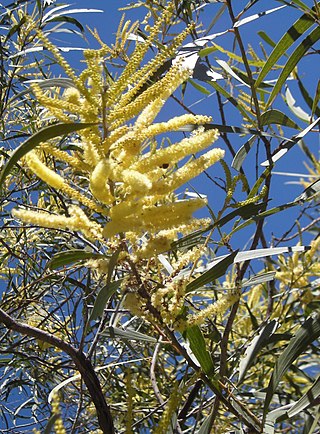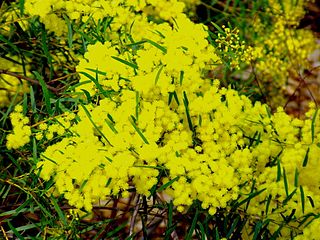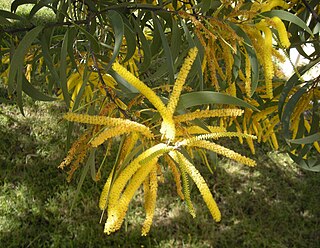
Acacia melanoxylon, commonly known as the Australian blackwood, is an Acacia species native to south-eastern Australia. The species is also known as blackwood, hickory, mudgerabah, Tasmanian blackwood, or blackwood acacia. The tree belongs to the Plurinerves section of Acacia and is one of the most wide-ranging tree species in eastern Australia and is quite variable mostly in the size and shape of the phyllodes.

Acacia aulacocarpa, also known as New Guinea wattle or golden flowered salwood, is an Australian shrub or tree in the family Fabaceae. It is found in northern Australia, Papua New Guinea, Irian Jaya and parts of Indonesia.

Acacia penninervis, commonly known as mountain hickory wattle, or blackwood, is a perennial shrub or tree is an Acacia belonging to subgenus Phyllodineae, that is native to eastern Australia.

Acacia enterocarpa, commonly known as jumping jack wattle, is a shrub species that is endemic to eastern Australia.

Acacia fimbriata, commonly known as the fringed wattle, Brisbane golden wattle, or just the Brisbane wattle, is a species of Acacia that is native to much of the east coast of Australia. It is one of the floral emblems of the city of Brisbane, Queensland.

Acacia podalyriifolia is a perennial tree which is fast-growing and widely cultivated. It is native to Australia but is also naturalised in Malaysia, Africa, India and South America. Its uses include environmental management and it is also used as an ornamental tree. It is very closely related to Acacia uncifera. It grows to about 5 m in height and about the same in total width. It blooms during winter.

Acacia leiocalyx grows in Queensland, Australia and as far south as Sydney. It is widespread and common in eucalypt woodlands, especially on well-drained, shallow soils. It is short-lived and grows 6–7 metres (20–23 ft.) tall, with a trunk about 180 mm in diameter.

Acacia leptocarpa, commonly known as north coast wattle, is a shrub or small tree native to New Guinea and coastal regions of northern Australia.

Acacia jibberdingensis, also known as Jibberding wattle or willow-leafed wattle, is a shrub or tree belonging to the genus Acacia and the subgenus Juliflorae that is endemic to Western Australia.

Acacia thomsonii, commonly known as Thomson's wattle, is a shrub or tree belonging to the genus Acacia and the subgenus Juliflorae that native to parts of northern Australia.

Acacia rossei, also known as Yellowdine wattle, is a shrub of the genus Acacia and the subgenus Phyllodineae that is endemic to south western Australia.

Acacia crassa, commonly known as the curracabah, is a species of Acacia native to eastern Australia.

Acacia burbidgeae, commonly known as Burbidge's wattle, is a shrub or tree belonging to the genus Acacia and the subgenus Phyllodineae that is endemic to parts of New South Wales and Queensland.

Acacia neobrachycarpa is a shrub belonging to the genus Acacia and the subgenus Phyllodineae endemic to Queensland.

Acacia calantha is a shrub belonging to the genus Acacia and the subgenus Phyllodineae native to Queensland in Australia.

Acacia holotricha is a shrub belonging to the genus Acacia and the subgenus Phyllodineae that is native to parts of north eastern Australia.

Acacia saxicola, commonly known as Mount Maroon wattle, is a shrub belonging to the genus Acacia and the subgenus Phyllodineae native to eastern Australia.

Acacia leichhardtii, commonly known as Leichhardt's wattle, is a shrub of the genus Acacia and the subgenus Phyllodineae that is endemic to north eastern Australia.

Acacia caroleae, also known as Carole's wattle or narrow leaf currawong, is a shrub belonging to the genus Acacia and the subgenus Juliflorae that is native to north eastern Australia.
Acacia argyrotricha is a shrub of the genus Acacia and the subgenus Plurinerves that is endemic to north eastern Australia




























